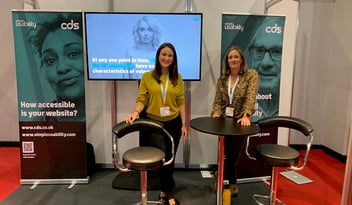As professional communicators, our job is to encourage inclusive copy
Posted in Inclusivity and Accessibility, Experience Transformation
August 2020
3 minutes reading time
This post about inclusive copy first appeared recently in Influence PR magazine, source: https://influenceonline.co.uk/2016/01/25/about-influence/
From 23 September 2020, public sector organisations will have a legal duty to make sure their websites and apps meet accessibility requirements. But the basic need for corporations to understand diversity, and subsequently foster inclusion, is nothing new.

While inclusivity is something, we should all take responsibility for, as communicators it’s important not to create an exclusionary environment – however accidentally.
While there are several interpretations of what diversity means, it ultimately focuses on understanding individual differences – whether that be someone’s race, ethnicity, gender, sexual orientation, socioeconomic status, age, health – both physical and mental – religious or political beliefs.
Generating inclusive copy meanwhile, involves sharing information in a way that everybody can understand – no matter who they are.
Public sector organisations, by their very nature, spend a significant amount of time communicating with a large and diverse range of people. A local council, for example, has to juggle the sending of routine information (e.g. bin collections and roadworks), with more targeted and tailored information (e.g. benefits and social housing).
Understanding the specific needs, expectations and barriers of those on the receiving end of communications is essential. It is the only way to ensure you create communications that will be understood and acted upon by those you are trying to reach.
However, professional communicators, be it in the world of PR, marketing or journalism can often assume readers have a similar level of understanding of a particular topic. In doing so, they run the risk of including technical jargon, or language which readers find difficult to comprehend – resulting in the audience completely disregarding or misconstruing the message.
5m adults have a sub-11 reading age
To put this into context, in 2019, The National Literacy Trust estimated that 5.1 million adults in England are functionally illiterate and can understand only the most straightforward, short texts on familiar topics.
Our own research, conducted with YouGov in 2019, found 67% of people have experienced a problem with an organisation’s communications which led them to not understand the message. When you take a step back to think about the people on the receiving end, it becomes apparent just how easily a poorly-thought out, confusing piece of comms can become a significant barrier for consumers.
Vulnerable people are especially at risk in this area as they are already likely to feel excluded and lacking in confidence. In our research, some of the vulnerable people we spoke to had a tendency to blame themselves for not understanding something. But, as professional communicators, we have a duty of care to make sure messaging can be understood by those it is meant for.
Therefore, if there isn’t a diverse group of people creating the copy – or at least reviewing it before it is disseminated – there is a significant risk that it won’t resonate with the diverse group of people reading it.
So, what can be done?
Firstly, agencies should look at the type of candidates they are attracting – and hiring – regardless of the sector they operate in. Creating an inclusive environment where everyone feels comfortable and can voice their opinions, will ultimately help them – and the wider business – to thrive.
Secondly, thought must be given to the target audience of each and every piece of prose, as what is interesting and relevant to one group, may be bewildering to another. Take a local newspaper as an example. The typical reader of a printed newspaper is highly likely to be a very different demographic to those who access the same newsfeed digitally – via a website, app or social media feed. So, should print content ‘make do’ for its digital equivalent – and vice-versa?
Unfortunately, for a long time, people have been guilty of writing for people like themselves – through no fault of their own. While some may argue there isn’t the time or the budget to research and create bespoke communications to cover all audiences, the converse argument is that the potential for conversion via targeted and tailored messaging will ultimately pay dividends in the longer term.
Copy and paste content
Technology has paved the way for a new dawn of efficiency within the media, but it also means that a lot of content – when used in the public domain – can simply be copied, pasted and shared in a matter of minutes.
For PR professionals, press releases which are used as-is, can feel like a ‘win’ from a client’s point of view. But, is the language used in a digital version of a campaign right for that platform’s demographic? Or should two versions be created in order to send the right message, to the right people?
Of course, a complex whitepaper, lengthy awards entry or thought-provoking opinion piece may only ever be intended for a small, focused audience. While national, consumer campaigns may intentionally throw the net wide. But, when prose is being disseminated to a diverse society, it’s important to consider whether it really hits the mark.
Ensuring your organisation endeavours to foster inclusive communications will ultimately safeguard the long-term future of the firm – regarding both the bottom line and customer trust. Therefore, as professional communicators, it’s our job to find a way to persuade those around us to strive for accessibility for all.



